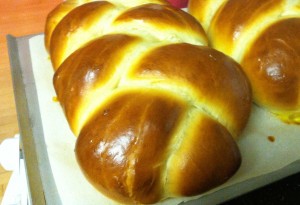I’m back from my blog holiday, and I’m ready to rumble. In one corner we have challah, soft, eggy, golden, and faintly sweet.
 In the other we have brioche, decadent and rich with butter. Which will emerge victorious? Which will claim the french toast crown?
In the other we have brioche, decadent and rich with butter. Which will emerge victorious? Which will claim the french toast crown?
Over Christmas a friend asked me where in town she could get brioche. She had heard that it made the best french toast. This lead to a discussion of how to make the best french toast. I grew up eating it made from challah, and I suppose you see where this is going.
Which was better? I had to know. I made challah. I made brioche. I invited a few friends over to assist with the taste testing. In the end, we decided that there is no such thing as bad french toast and we would happily consume either. When forced to choose, the challah came out slightly ahead, but it was a far from unanimous decision.
Make them both and try it for yourself. You can find the challah recipe on Jasper’s blog here. My favourite brioche, from Baking with Julia, is posted below, with my modifications. Note that unlike challah, which can be made in an evening, brioche takes some time, so plan to start a day ahead.
Basic Brioche (adapted from Baking with Julia)
Make the sponge:
- 1/3 cup warm milk
- 2 1/3 tsp. yeast
- 1 egg
- 2 cups flour
- Mix the milk, yeast and egg with 1 cup of the flour until blended. Sprinkle the remaining cup of flour over the top.
- Set the sponge aside to rest for 30 to 40 minutes. As it rises the flour coating will crack. This is a good sign.
Make the dough:
- the sponge
- 1/3 cup sugar
- 4 eggs
- 1 1/2 cup flour
- 6 oz. butter, at room temperature
- 1 egg, beaten with 1 T. water, for the egg wash
- Add the sugar, 4 eggs, salt, and 1 cup of flour to the sponge. In a stand mixer, knead with the dough hook just until the ingredients come together.
- Add the remaining flour and beat for 15 minutes. Be warned, your mixer will get very hot. During this time the dough should come together and start slapping the side of the bowl as it goes around. If it is too soft to do this add a bit more flour. If it is too stiff, drizzle in a little milk.
- Massage the butter in your hands until it is soft and pliable.
- Add the butter, a tablespoon at a time, until it is all incorporated. Initially your dough will fall apart. Don’t worry. It will come back together by the end.
- Cover the dough with plastic wrap and let it rise until doubled, about 2 to 2 1/2 hours.
- Punch the dough down, cover the dough again, and put it in the fridge overnight.
- Butter two loaf pans
- Divide the dough in half, and divide each half into six pieces.
- Shape each piece into a ball and place them in the prepared pans – side by side so tha each pan has three short rows of two.
- Let the loaves rise two hours.
- Preheat the oven to 375.
- Brush the egg wash over the risen loaves and bake them for 30 minutes, until they are a deep golden brown
- If you’re not using them for french toast, eat them warm out of the oven. They taste best that way.

